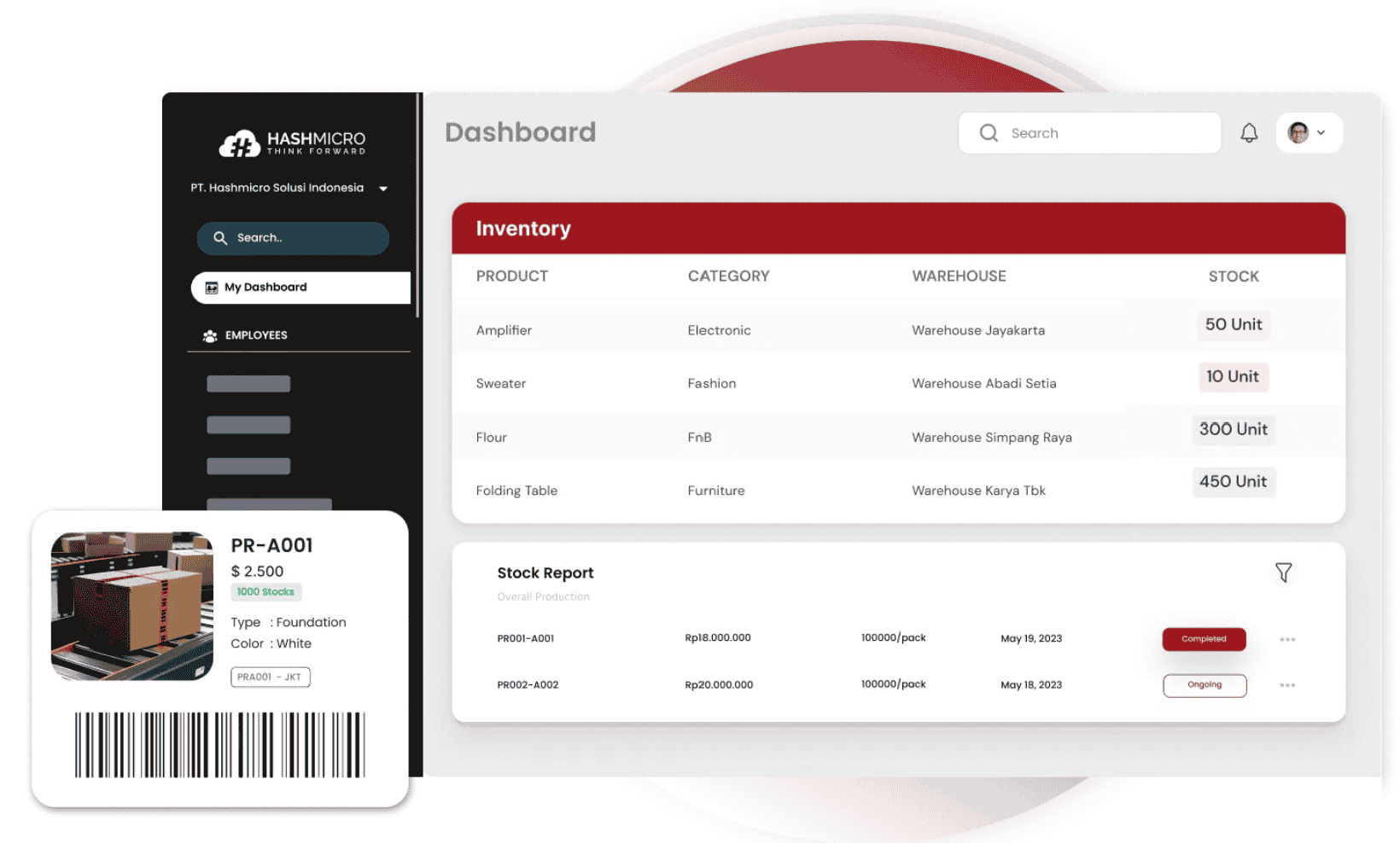Managing Work in Process (WIP) inventory is essential for efficient production, cost control, and timely deliveries. However, businesses in Singapore face unique challenges, such as high operational costs, limited storage space, and the need to align production schedules with inventory availability.
Additionally, strict quality standards from the Office of Economic Development (OED) and the demands of global supply chains make inventory management even more complex. Without the right tools, businesses risk inefficiencies, increased waste, and missed opportunities to optimize their operations.
To stay competitive, companies must embrace smart inventory solutions like HashMicro. With features such as RFID automation, stock forecasting, and real-time tracking, businesses can streamline production, minimize downtime, and ensure compliance with OED standards. Let’s dive deeper into these challenges and solutions in this article.
Key Takeaways
|
Table of Content:
Table of Content
What is Work in Process Inventory?
Work in Process (WIP) inventory refers to goods that are partially finished and still in the production phase. These are materials that have undergone some transformation but are not yet ready for sale. For example, in the coffee industry, WIP inventory may include roasted beans, packaging materials, and boxes awaiting shipment.
Although WIP inventory isn’t yet a finished product, it is still a valuable asset on your balance sheet, representing the investment made during the production process. Understanding the value of these goods is crucial in assessing the overall worth of your operations.
Efficiently managing WIP inventory is key to avoiding production delays and bottlenecks, ensuring a seamless transition from raw materials to finished products.
By striking the right balance with your WIP inventory, businesses in Singapore can stay competitive and optimize their operations in the fast-paced, ever-evolving market. Proper management helps streamline production and ensures that businesses are well-positioned to meet customer demands on time.
What are the Benefits of Work in Process Inventory?
Managing Work in Process (WIP) inventory efficiently offers a wide range of benefits that can significantly enhance your business operations. In Singapore’s competitive landscape, where operational costs are high, streamlining your WIP management is essential for staying ahead. Here are some of the key benefits of efficient WIP management:
- Optimized Production Flow: By closely tracking WIP, you can identify bottlenecks early and address them before they disrupt production. This not only streamlines the production process but also speeds up delivery times, leading to higher customer satisfaction.
- Cost Control: Proper management of WIP minimizes excess inventory, reducing storage costs and waste. This ultimately helps lower your overall production expenses, allowing for more efficient use of resources.
- Improved Resource Allocation: Tracking WIP ensures that labor, materials, and equipment are allocated efficiently. This optimizes resource use, preventing both overuse and underuse, which can result in costly inefficiencies.
- Enhanced Quality Control: Regularly reviewing WIP allows you to catch quality issues early in the production process. By addressing potential problems before they escalate, you can avoid expensive rework and maintain high product standards.
- Better Forecasting and Planning: Having clear visibility into your WIP inventory allows you to forecast demand more accurately and adjust production schedules accordingly. This helps prevent overproduction and shortages, ensuring your operations stay in balance.
- Increased Customer Satisfaction: Faster production cycles combined with consistent product quality led to quicker turnaround times, boosting customer loyalty and enhancing your brand reputation.
- Time Efficiency: With automated WIP tracking systems, you save time on manual inventory counts, freeing up your team to focus on more strategic tasks that drive business growth.
What is the Function of Work in Process Inventory?
Work in Process (WIP) inventory plays a vital role for businesses. It helps track the progress of goods through production, ensuring smoother operations by identifying bottlenecks early and optimizing resource allocation.
WIP is also crucial for financial management, allowing businesses to allocate costs accurately and assess profitability. Reducing excess inventory, WIP frees up capital, improves cash flow, and lowers storage costs. It also aids in quality control, enabling early detection of issues and enhancing product standards.
For project-based industries, WIP helps monitor progress, manage resources efficiently, and keep projects on track. For supply chain management, WIP ensures timely raw material delivery and consistent product availability, boosting customer satisfaction.
Lastly, accurate WIP data supports informed decision-making, optimizing production schedules and aligning resources with market demand. This streamlined approach is essential for businesses in Singapore to stay competitive and efficient.
What is the Difference Between Work in Process Inventory and Work in Progress?
Understanding the difference between Work in Process (WIP) inventory and Work in Progress (WIP) is crucial for businesses to manage their operations effectively. While the terms are often used interchangeably, they refer to distinct concepts.
Work in Process inventory refers to goods that are in various stages of production but are not yet completed. These items are moving through manufacturing processes, such as partially assembled electronics or food products. This term is primarily used in industries with quick production cycles, such as food manufacturing and electronics assembly.
Work in Progress, on the other hand, describes larger and more complex projects that take longer to complete. It is commonly used in industries like construction, software development, and consulting. For example, a building still under construction or an ongoing client project would fall under Work in Progress.
The key distinction is that Work in Process relates to goods moving through quick production, while Work in Progress involves projects that require multiple stages over a longer period. By understanding these distinctions, businesses can improve their production and project management, optimizing workflows and resource allocation.
Why is It Important to Calculate Work in Process Inventory?
Calculating Work in Process (WIP) inventory is crucial for businesses to maintain accurate financial records and control production costs. It ensures that both finished and unfinished goods are reflected properly on the balance sheet, which is especially important for businesses offering customized products. This helps businesses accurately determine the cost of goods sold (COGS) and manage their profitability.
Tracking WIP inventory also helps identify bottlenecks in production. By calculating Work in Process days, businesses can pinpoint delays early and make adjustments before these slowdowns affect delivery timelines. Furthermore, accurate WIP calculations provide a clearer business valuation, preventing undervaluation of inventory and incorrect cost reporting.
Maintaining appropriate WIP levels also minimizes waste, including storage, labor, and utility costs. This improves overall efficiency and reduces unnecessary expenses. In conclusion, regularly calculating WIP inventory leads to better financial transparency, smoother operations, and enhanced profitability.
What is the Formula for Calculating Work in Process Inventory?
Calculating Work in Process (Work in Process) inventory involves determining the value of partially completed goods at the end of an accounting period. To make this process more straightforward, businesses can follow these key steps:
- Start with the Beginning Work in Process Inventory: This is the value of unfinished goods carried over from the previous period. It serves as the foundation for the current period’s calculation.
- Add Manufacturing Costs: These costs include raw materials, labor, and overhead that accumulate as production progresses. By factoring these costs, businesses can track how much has been invested in production during the period.
- Subtract the Cost of Manufactured Goods (COGM): This step accounts for the finished goods that are no longer part of the Work in Process inventory. COGM includes all costs directly tied to producing completed items. The formula for COGM is:
- Calculate Ending Work in Process Inventory: With the beginning inventory, manufacturing costs, and COGM in hand, businesses can now calculate the ending Work in Process inventory using the formula:
How is Work in Process Inventory Calculated?
To calculate Work in Process (WIP) inventory, start with the beginning inventory value, add the manufacturing costs for the period, and subtract the Cost of Goods Manufactured (COGM) for that period. For example, if your beginning WIP inventory is $10,000, your total manufacturing costs amount to $300,000, and the COGM for the period is $250,000, the calculation would be as follows:
Ending Work in Process Inventory = ($10,000 + $ 300,000) – $250,000 = $60,000
This $60,000 represents the WIP inventory at the end of the period, which will be carried over as the beginning WIP inventory for the next period.
By using this formula, businesses can maintain an accurate, up-to-date view of their WIP inventory. This practice ensures better financial management and inventory control, enabling businesses to streamline their production processes while keeping their financial records precise and reliable.
How Can You Reduce Work in Process Inventory?
Reducing Work in Process (WIP) inventory is essential for businesses looking to enhance efficiency and cut unnecessary costs. Here are some strategies that can help manage and reduce WIP levels:
1. Embrace lean manufacturing and just-in-time (JIT)
Implementing JIT production ensures that materials arrive only when needed. This reduces overproduction and excess inventory, which helps minimize carrying costs and speed up inventory turnover. As a result, WIP levels remain controlled while waste is minimized.
2. Identify and resolve bottlenecks
Bottlenecks often cause delays in production, leading to extended WIP times. To address this, analyze your production line to pinpoint slowdowns. By allocating more resources to these areas, whether in labor or machinery, you can eliminate bottlenecks and reduce WIP duration.
3. Refine production planning and scheduling
Efficient scheduling plays a key role in reducing WIP. With the help of advanced planning tools, businesses can ensure smooth operations, minimize idle time, and avoid backlogs. Proper planning balances workloads, ensuring that each production stage operates efficiently.
4. Leverage inventory management software
Real-time inventory management systems allow businesses to track materials accurately and forecast demand more effectively. This prevents overordering and helps maintain leaner WIP inventories by providing visibility into stock levels.
5. Invest in employee training and upgraded machinery
Skilled employees and advanced machinery significantly reduce WIP time. Training ensures your team is efficient, while upgrading to faster, more capable equipment increases production capacity and reduces delays.
6. Implement a pull-based system
A pull-based inventory system, like Kanban, ensures production occurs based on actual demand rather than forecasts. This helps prevent overproduction and reduces WIP inventory by producing goods only when needed.
7. Collaborate with suppliers
Strong relationships with suppliers ensure timely deliveries, which reduce waiting times and prevent WIP buildup. A reliable supply chain minimizes disruptions and keeps production moving smoothly.
8. Cultivate a culture of continuous improvement
Adopting methodologies like Kaizen or PDCA (Plan-Do-Check-Act) allows businesses to regularly evaluate and refine production processes. This ongoing improvement reduces WIP inventory while boosting overall productivity.
What are the Common Challenges of Managing Work in Process Inventory?
Managing Work in Process (WIP) inventory presents several challenges that businesses must address to ensure smooth operations. Below are some of the key challenges:
1. Inaccurate tracking
Errors in tracking can lead to delays, shortages, or overstocking, causing inefficiencies in production. Without accurate data, businesses struggle to maintain optimal inventory levels, leading to higher costs. Implementing a cloud-based inventory system can help reduce these issues and improve overall efficiency.
2. Inventory imbalance
Excessive WIP inventory increases storage costs and the risk of material obsolescence, leading to waste. On the other hand, insufficient inventory can disrupt production schedules and reduce operational efficiency. A cloud-based inventory system enables better tracking and forecasting to maintain the right balance.
3. Inefficient production scheduling
Poor scheduling leads to bottlenecks, slowing down production and increasing inventory buildup. When production is not properly planned, resources are underutilized, resulting in unnecessary costs. Using a cloud-based inventory system helps optimize scheduling by providing real-time data on inventory flow.
4. Poor communication between departments
Miscommunication disrupts the flow of materials, causing production delays and excess inventory. When departments operate in silos, coordination becomes difficult, leading to inefficiencies. A cloud-based inventory system centralizes data, improving collaboration and workflow integration.
5. Fluctuating customer demand
Unpredictable demand makes it difficult to forecast inventory needs, increasing the risk of stockouts or overproduction. Sudden demand spikes can overwhelm production, while slow demand leads to excess inventory. A cloud-based inventory system enhances forecasting accuracy through data analytics and real-time tracking.
6. Outdated manual processes
Traditional inventory management methods are time-consuming and prone to errors, limiting scalability. As businesses grow, manual tracking becomes inefficient and affects decision-making. Transitioning to a cloud-based inventory system improves accuracy, efficiency, and operational agility.
7. Lack of real-time visibility
Without real-time inventory insights, businesses struggle to make informed decisions, leading to inefficiencies. Delayed or inaccurate data can cause misallocation of resources and missed opportunities. A cloud-based inventory system provides instant access to inventory status, enabling better control and decision-making.
How Can Inventory Software Help Optimize Work in Process Inventory Management?
Optimizing Work in Process (WIP) inventory is essential for maintaining smooth operations, reducing waste, and enhancing productivity. Inventory management software can significantly simplify this process by providing real-time visibility, automation, and tools that improve operational efficiency.
HashMicro Inventory Software is specifically designed to meet the needs of businesses in Singapore, offering a range of features that streamline inventory management and drive growth:
1. Omni-channel integration
Singapore currently has experienced a fast-growing online shopping and delivery landscape. Adjusting to the current situation through seamless integration with platforms like Lazada, Shopee, and GrabFood could help business easily. This feature allows businesses to track inventory across multiple channels, expanding their reach and increasing sales without added complexity.
2. Stock optimizer
With Singapore’s competitive market, effective inventory management is crucial. This feature ensures accurate stock tracking and order optimization, preventing overstocking or shortages. As a result, businesses can improve their operations and cut unnecessary costs.
3. Loyalty point management
Building strong customer relationships is vital in Singapore’s value-driven market. This feature helps businesses manage customer loyalty points, promoting repeat purchases and fostering long-term loyalty, which is key to maintaining a competitive edge.
4. Hybrid mode – online and offline
Even during connectivity issues, this feature allows businesses to continue processing transactions offline and sync them automatically once online, ensuring uninterrupted operations, especially in retail or restaurant environments.
By leveraging HashMicro Inventory Software, you can optimize WIP inventory, improve efficiency, and enhance customer satisfaction.
Conclusion
Effectively managing Work in Process (WIP) inventory is key to boosting productivity, controlling costs, and meeting customer expectations. Understanding its role and benefits helps companies address production delays, improve forecasting, and streamline their workflows.
Implementing advanced inventory management tools further enhances efficiency, reduces waste, and ensures smoother production cycles. Strategies such as lean manufacturing, improved supplier collaboration, and accurate demand forecasting enable businesses to stay ahead of the competition.
Proactively managing WIP inventory not only strengthens operational efficiency but also supports sustainable profitability and growth.
For businesses in Singapore, inventory management software provides a comprehensive solution to optimize inventory control. With accurate insights into your WIP inventory, you can make informed decisions and improve your processes. Try our free demo today and discover how it can transform your business.
Pertanyaan Seputar Work in Process Inventory
-
What is MRO inventory?
MRO inventory stands for maintenance, repair, and operation inventory. This classification includes all the supplies a business needs for its production process that do not become part of an end product. MRO inventory is often overlooked because it doesn’t generate revenue—at least not directly.
-
What is an example of WIP?
An example of a work-in-process may include manufactured goods. Work-in-progress, as mentioned above, is sometimes used to refer to assets that require a considerable amount of time to complete, such as consulting or construction projects
-
What is a good WIP limit?
If WIP limits are being applied across the team, a good starting place is the number of team members plus one, so if you have 10 members working on a board, implement a WIP limit of 11 as a starting point.


























































